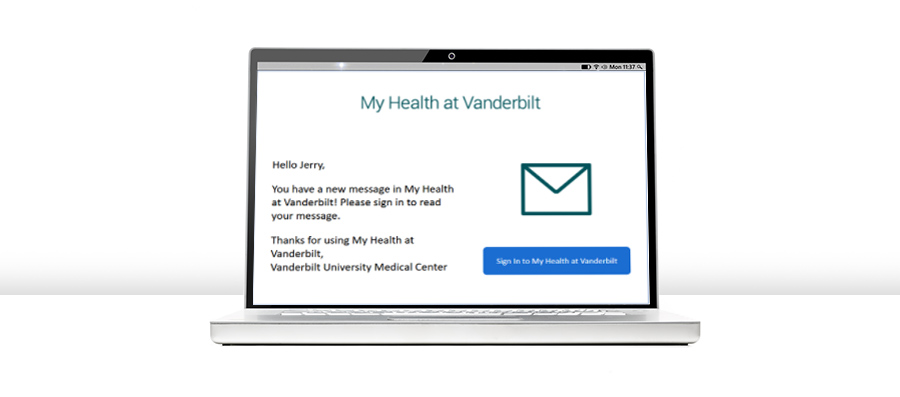I recently received an email from my physician’s office that read as follows.

The email was a surprise. I was not expecting test results or any other type of correspondence from my physician. A little anxious to know what was going on, I logged in right away.
When I opened my health record there was an eLetter from my primary care physician notifying me that he would no longer be seeing patients at the office where I receive care. My next follow-up appointment was scheduled to take place within just a few short weeks from when I received the email, which meant I had to find a new primary care physician right away.
 My First Hope
My First Hope
My first hope was that maybe, just maybe, my primary care physician was simply moving to another office location within the same healthcare system and would still be seeing patients within my metropolitan area. If that were the case, I’d be more than willing to drive a little further to see my provider, especially since he had worked so hard for two years to help me manage a couple of chronic medical conditions, resulting in much improved medical outcomes. My relationship with my primary care provider was just amazing, and with my chronic medical conditions finally under control, the thought of finding a new primary care physician was daunting.
I read and re-read the eLetter. There was no indication that my primary care provider would be seeing patients at another location in my area. I suddenly came to the sobering realization that I would have to find another primary care provider.
The eLetter did, however, make mention that there were three other providers at this particular office that were available to take over supervising my care. Looking back on all the collaboration and hard work it took to get my chronic conditions under control, it made me realize that selecting a new primary care physician was not something I could take lightly. Unfortunately, none of the other three providers met my care requirements and preferences.
 No Luck – I Was Stuck
No Luck – I Was Stuck
I did what most patients would do when looking for a new primary care physician; I asked family and friends for recommendations, checked online reviews, including Google ratings, reviewed several provider CV’s on the internet, and otherwise exhausted just about every avenue possible. No luck, I was stuck.
Part of what caused me to get ‘stuck’ was the thought of potentially transferring my medical records to a new physician, across to a different healthcare system.
Having a patient portal that works well has been a real asset in helping me control the chronic conditions that I mentioned earlier. Whenever I access my health records, I can review several, measurable clinical markers that I have watched improve over time. Having easy access to my health record has motivated me to be more compliant in following my wellness care plan.
Whenever my primary care physician was not available to see me, my up-to-date medical information was always readily available to the attending care team member. When I was seen by another provider, or whenever I had to visit the urgent care facility, because the entire care team had access to the same medical information, I had experienced first-hand the health benefits of an Electronic Health Record (EHR). The efficiency of my care team’s use of my EHR was also a real convenience to me, as the patient. From a patient’s perspective, I can attest to the health benefits and convenience of an Electronic Health Record, when used the way it was designed.
The thought of transferring and potentially leaving behind some or all of my health information was not something I wanted to contemplate.
Clinical Quality Improvement
Some time ago I wrote a blog about clinical quality improvement. Now that I have personally experienced the favorable outcomes of coordinated care, I would like to revisit with you some of the key points to achieving improved clinical outcomes.
The Greatest Strategic Challenge
When it comes to clinical quality improvement, healthcare leaders consider coordinated care to be the greatest strategic challenge. (1) Care coordination is not really a new problem; it is just that value-based care has placed a greater sense of urgency on solving the coordinated care dilemma. As the healthcare industry focuses on improving the patient experience, successfully coordinating the patient’s journey through every point of care has become an even larger piece of the puzzle.
Many challenges exist when it comes to improving care coordination. A study from the Journal of American Board of Family Medicine found the following to be key factors of improving care. (2)
- Functionality of Clinical Information Technology
There is no shortage of new, emerging technologies all designed to improve the exchange of information, even so, the exchange of medical information continues to be a challenge. Interoperability is the missing link in many cases; between specialists, disparate hospital systems, and especially across healthcare systems. While solving the technical barriers can be a challenge, the larger, more difficult challenge to solve may well be the lack of cooperation between healthcare organizations. - Community Resources
Difficulty finding community resources for patients is an ongoing challenge. Some examples include; transportation to and from appointments, affordable medications and supplies, chronic disease management, smoking cessation programs, obesity programs, low-cost dental care, and access to behavioral health. - Interactions with Patients
There remains a huge challenge related to some patients’ lack of trust, in general, with the healthcare system. This lack of trust results in the unwillingness (or inability) of many patients to take responsibility for the self-management of chronic diseases. - Interactions Between Disparate Healthcare Organizations
Interactions between disparate healthcare organizations are often THE barrier to care coordination. Conversely, good working relationships across health care facilities were found to be beneficial.
Although there are numerous challenges to patient care coordination, with the fluid exchange of medical information improved clinical outcomes are achievable.
 My Decision
My Decision
Not willing to risk the transfer of my medical records to a new healthcare system, I chose a new primary care physician who sees patients at the same office location as my previous primary care provider, remaining within the same healthcare system.
My primary reason to stay within the existing healthcare system was anchored in the realization that the fluid exchange of medical information sets the foundation for effective care coordination. Having enjoyed the health benefits of effective care coordination, I chose to stay with the healthcare organization that made that exchange of information possible by providing a patient-friendly EHR.
Please let us know if you have comments or questions, and subscribe to our Email Updates so that you can be assured to receive Thinking Thursdays TIPs and other articles from our blog.
Thank you!
Jerry
REFERENCES:
- http://www.beckershospitalreview.com/healthcare-information-technology/care-coordination-leads-as-biggest-challenge-for-hospitals-pursuing-population-health-management.html
- http://www.jabfm.org/content/29/1/90.full



